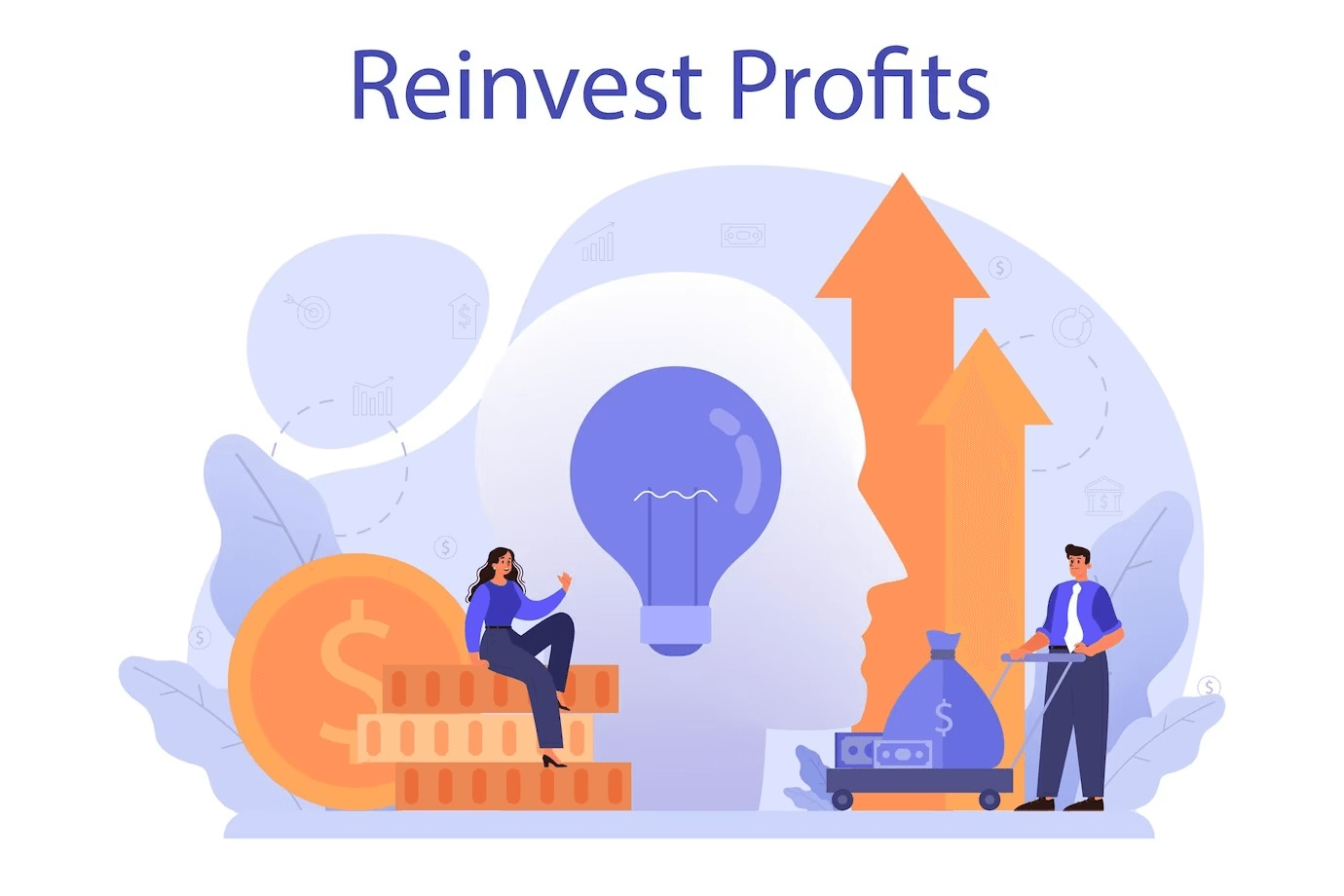How to Invest 100k to Make 1 Million Dollars: Your Guide to Financial Growth
Picture this: You've got $100,000, and it's burning a hole in your pocket—not because you're eager to spend it, but because you see it as a seed, one that could grow into a mighty $1 million tree. Sounds like a fairytale? Well in the world of strategic investing, this can turn into tangible wealth!
Investing isn't just for the financial wizards and Wall Street tycoons; it's a journey we can all embark on. Whether you're a novice investor standing on the threshold of opportunity or a seasoned pro looking to multiply your gains, this guide is your roadmap. Read on as we shed light on an often-asked question: "How to invest 100k to make $1 million?"
Understanding Investment Basics
Before diving into the specifics, it's essential to grasp some key investment principles. The world of investing revolves around three cornerstones: risk and return, diversification, and compound interest.
Risk and return are two sides of the same coin. Generally, investments that carry more risk have the potential for higher returns. This is where risk tolerance comes into play. What risks can you take to achieve your financial goals? Good financial advisors and wealth managers like Lyons Wealth can help you evaluate this.
Diversification is basically splitting up your investments among a variety of asset classes to help minimize potential risks. The old proverb, "Don't put all your eggs in one basket," truly applies here. This can involve a mix of exchange-traded funds, mutual funds, index funds, stocks, bonds, and real estate investing, among other things.
Compound interest plays a pivotal role in wealth accumulation. It's the principle where your interest earns interest, causing wealth to grow at an exponential rate. Even modest amounts, given enough time, can grow into significant sums thanks to the magic of compounding.
Strategic investment, incorporating these principles, can lead to substantial financial growth. By understanding and applying these principles, you increase the potential of your first investment of $100k to grow into a million-dollar portfolio. Remember, investing involves risk, but with careful planning and sound strategies, the journey to $1 million becomes attainable.
Setting Realistic Time Frames and Growth Expectations
The journey from $100k to $1 million starts with setting a realistic time frame and understanding growth expectations. We first need to understand that investing isn't a get-rich-quick scheme.
It requires patience, consistency, and a clear financial strategy. Based on historical average returns, one can project an estimated time frame for reaching the million-dollar milestone. Remember, these are just estimates, actual returns may vary due to market fluctuations.
How to Invest 100k to Make 1 Million Dollars: Different Investment Options
To transform your $100k into a million dollars, it's essential to understand the diverse investment options available and their risk and return characteristics. Here's a detailed look at potential avenues:
- Stock Market: Buying shares of companies can offer significant returns, especially growth stocks. If you're aiming to grow $100k to $1 million, consider allocating a portion of your capital to stocks with proven performance or sectors with strong growth potential. Remember, timing and research are key here. Stocks can be volatile, offering both tremendous growth and significant losses.
- Real Estate: Income-producing real estate and real estate investment trusts (REITs) offer a stable, passive income and potential appreciation. With $100k, you could put a down payment on a rental property in an emerging market or diversify through REITs, which pool investments in various real estate sectors. Rental properties could generate monthly income and appreciate in value over time.
- Bonds: These are considered low-risk compared to stocks and real estate. While the returns are lower, they provide steady income and are less susceptible to market volatility.
- Exchange Traded Funds (ETFs): These are securities that track an index and are traded on investments like stocks. ETFs provide diversification, are more cost-effective than mutual funds, and can be a valuable asset to your portfolio.
- Mutual Funds: A professionally managed mutual fund pools money from multiple investors to invest in a portfolio of stocks and other assets. While there are fees involved, diversification and professional money management can be worth it.
- Index Fund: These are mutual funds or ETFs, but their goal is to that aim to imitate the performance of a specific index. They are popular for their low costs and diversification. Low-cost index funds can be particularly appealing.
- High-Yield Savings Account: These accounts offer higher interest rates than standard saving accounts. While they won't make you a millionaire overnight, they are virtually risk-free and provide steady, albeit modest, returns.
- Money Market Account: A money market account is another investment option to consider in your financial arsenal. It's a type of savings account that often requires a higher minimum balance but offers a higher interest rate than standard savings accounts. Money market accounts offer more liquidity, allowing you to withdraw a limited number of times per month.

In terms of contribution towards the $1 million goal, a balanced mix of these options based on your risk tolerance and investment strategy can work wonders. Still, the best investment for you depends on your individual circumstances, which is where a financial advisor can provide invaluable guidance.
How to Split the $100k Among Different Investment Options
Diversification is an essential strategy that can help mitigate investment risk. You should consider splitting your $100k into different investment prospects like index funds, exchange-traded funds, and income-producing real estate.
Each of these offers unique advantages and disadvantages and the allocation should align with your risk tolerance, financial goals, and investment plan. For instance, index funds and ETFs offer broad market exposure, while real estate investing and high-yield savings accounts can provide steady cash flow.
Remember, while these steps provide a roadmap, everyone's financial situation is unique. A financial advisor can help you navigate through the investing process effectively. At Lyons Wealth, we tailor strategies to your financial circumstances.
Investment Strategy
An effective investment strategy is the backbone of achieving your million-dollar goal. Particularly, a long-term strategy helps smooth out short-term market volatility and allows your investments to compound, maximizing growth. Here are some strategies that could help maximize growth:
- Dollar-Cost Averaging (DCA): This involves investing a fixed amount regularly, regardless of the market conditions. The benefit of DCA is that it eliminates the need to time the market. In fluctuating markets, you'll buy more units when prices are low and fewer when prices are high, which can potentially lower the total average cost per share of your investment.
- Reinvesting Dividends: This is a powerful tool for long-term wealth accumulation. By reinvesting the dividends you receive from your investments—be it the stock market, index funds, or ETFs—you buy more shares that will also generate dividends, creating a compounding effect that can significantly boost your portfolio over time.
- Continuous Portfolio Rebalancing: Over time, some of your investments may outperform others, causing your portfolio to deviate from its target asset allocation. You need to make adjustments to your portfolio occasionally to maintain your expected level of risk and return attributes.

A consistent, disciplined approach to your investment strategy, keeping in mind your risk tolerance and financial goals, can make the path to becoming a millionaire with your initial investment more attainable. Lyons Wealth can help guide you through the complexities of crafting and maintaining a suitable strategy tailored to your circumstances.
How Long Does It Take to Turn 100k into 1 Million through Investing?
The time it takes to turn $100k into $1 million through investing varies based on factors like the type of investments, the return rate, and whether returns are reinvested.
Assuming an average annual return of 7%, and reinvesting all gains, it could take approximately 30 years to reach $1 million. However, this can fluctuate based on market conditions and personal financial strategy.
Common Mistakes to Avoid
When it comes to investing $100k with the goal of reaching a million dollars, there are common pitfalls that can hinder your progress. Being aware of these can help you avoid setbacks and keep you on track toward your goal.
Overestimating Returns
One common mistake is overestimating potential returns, leading to unrealistic expectations and financial planning. Remember, average returns from investments like the stock market, index funds, and other funds fluctuate over time. Factoring in a conservative estimate of returns can create a more realistic growth trajectory.
Lack of Diversification
As mentioned, putting all your eggs in one basket can be a significant risk. Diversifying across stocks, bonds, real estate, and other investment options can spread the risk and increase potential returns.
Remember that different assets perform differently over time, and a diversified portfolio can provide a balance, ensuring you don't lose all your money if one investment performs poorly.
Not Reinvesting Returns
Reinvestment is a powerful tool for compound growth. By reinvesting dividends and capital gains back into your investment, you leverage the power of compounding, accelerating the growth of your investment over time.
Forgetting About Inflation and Taxes
Inflation and taxes can significantly erode your investment returns. Consider investments with tax benefits like a tax-advantaged retirement account and take into account the impact of inflation when calculating real return on investments. Strategies to minimize taxes and keep pace with inflation are vital in preserving your investment's purchasing power.
Avoiding these common missteps can significantly improve your journey to $1 million. Remember, professional advice from our team at Lyons Wealth can be invaluable in guiding your investment decisions and helping you navigate common investment pitfalls.
Conclusion
Transforming $100k into a million dollars is an ambitious but achievable goal. It involves understanding key investment principles, setting realistic timeframes, diversifying investments, and adhering to a long-term strategy that maximizes growth.
Patience and diligence are essential, as is the avoidance of common investment mistakes. Always remember, this journey is not a race but a marathon, requiring persistent, calculated strides.
Before making any investment decisions, it's wise to seek professional advice. At Lyons Wealth, our financial advisors are ready to provide personalized guidance based on your individual circumstances, helping you navigate the path toward your million-dollar goal.
Frequently Asked Questions
What is the safest way to invest 100k?
With an investment fund of $100,000, a range of avenues opens up for you. Secure options such as Certificates of Deposit (CDs) or high-yield savings accounts provide safety for your capital. Alternatively, you can step into the realm of stocks, assuming a level of risk for potentially higher returns. The choice in risk level is yours when investing.
Can I invest 100k to make $1 million without risk?
Investing will always have an associated risk. However, the degree of risk can be managed. Turning $100k into $1 million without any risk is highly improbable due to the nature of investment returns and market fluctuations. A balanced, diversified portfolio can help manage risk while seeking growth, but it's essential to consult with a financial advisor to understand all potential risks and rewards.